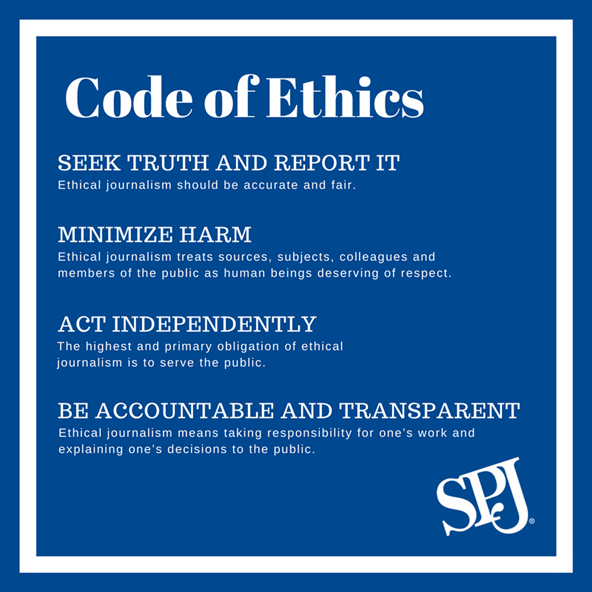 |
| The Code of Ethics of the Society of Professional Journalists. Source: the Society of Professional Journalists, spj.org |
In terms of ethical journalism, it's not unreasonable to think that all journalists should follow a common set of guidelines. In fact, that's so common of a thought that there are dozens of journalistic codes of ethics floating around, from that of the Society of Professional Journalists to what your uncle Bob thinks the TV man should be doing.
For the purposes of this class, we'll look at the codes of ethics from the following organizations: the Society of Professional Journalists (SPJ), the Radio Television Digital News Association (RTDNA), the National Press Photographers Association (NPPA), the American Advertising Federation (AAF), the American Society of Magazine Editors (ASME),the Public Relations Society of America (PRSA) and the Online News Association (ONA).
The Similarities
With so many different ethical codes, you would think that the seven organizations would disagree with each other on many points. However, most of the ethical codes look awfully similar. Here are a few things most, if not all, of the aforementioned societies agree on:
- all seven mention truth, accuracy and/or honesty
- six of the seven talk about maintaining independence or avoiding conflicts of interest
- all seven mention transparency, integrity and/or accountability
And they seem simple enough. Certainly, if these seven organizations (and perhaps others that deal with mass communication) wanted to make a common, overarching code for mass communication, the principles of honesty, independence and transparency is where they would probably start. It's also important, however, to note why the codes differ.
The Differences
In general, the differences between the codes have to do with the specifics of the medium. For instance:
- SPJ's code dives into the proper practices of reporting ethically
- "The right to broadcast ... does not mean it is always right to do so." - RTDNA code
- The second point in the NPPA code says to avoid staged photo ops
- The AAF code mentions the transparency behind endorsements
- Three points in the ASME code detail separating advertisements from coverage
- In the PRSA code, there is a specific section on loyalty to clients
- Freedom of expression is paramount to OMA's code, thanks in part to its "global reach"
It makes sense for all of these different societies to have their own specific code, rather than to combine them. Half the points in the NPPA code, for instance, would not apply at all to a member of the PRSA. It's incredibly important to lay out the specifics for the best ethical practices in each distinct medium.
And yet, the most striking part of these different codes of ethics is how similar they all are. Even in their differences, it's clear that the main points behind all guidelines come from the same sort of guiding ethical principles, which most of the codes spell out by name anyway.
Honesty. Independence. Transparency.
No comments:
Post a Comment